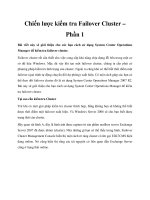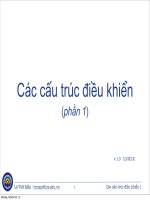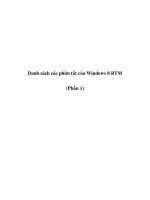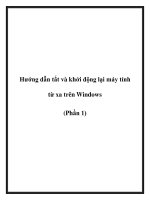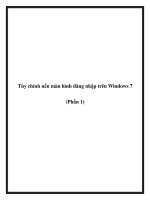websters new world Telecom Dictionary phần 1 potx
Bạn đang xem bản rút gọn của tài liệu. Xem và tải ngay bản đầy đủ của tài liệu tại đây (1.27 MB, 60 trang )
Telecom Dictionary
Ray Horak
TM
Wiley Publishing, Inc.
74570ffirs.qxd 9/11/07 12:14 PM Page iii
74570ffirs.qxd 9/11/07 12:14 PM Page ii
Telecom Dictionary
TM
74570ffirs.qxd 9/11/07 12:14 PM Page i
74570ffirs.qxd 9/11/07 12:14 PM Page ii
Telecom Dictionary
Ray Horak
TM
Wiley Publishing, Inc.
74570ffirs.qxd 9/11/07 12:14 PM Page iii
Webster’s New World® Telecom Dictionary
Published by
Wiley Publishing, Inc.
10475 Crosspoint Boulevard
Indianapolis, IN 46256
www.wiley.com
Copyright © 2008 by Wiley Publishing, Inc., Indianapolis, Indiana
Published simultaneously in Canada
ISBN: 978-0-471-77457-0
Manufactured in the United States of America
10 9 8 7 6 5 4 3 2 1
Library of Congress Cataloging-in-Publication Data
Horak, Ray.
Webster’s New World telecom dictionary / Ray Horak.
p. cm.
ISBN 978-0-471-77457-0 (pbk.)
1. Telecommunication—Dictionaries. I.Title.
TK5102.H65 2007
621.38203—dc22
2007024232
No part of this publication may be reproduced, stored in a retrieval system or transmitted in any form or by any means,
electronic, mechanical, photocopying, recording, scanning or otherwise, except as permitted under Sections 107 or 108 of
the 1976 United States Copyright Act, without either the prior written permission of the Publisher, or authorization through
payment of the appropriate per-copy fee to the Copyright Clearance Center, 222 Rosewood Drive, Danvers, MA 01923,
(978) 750-8400, fax (978) 646-8600. Requests to the Publisher for permission should be addressed to the Legal Department,
Wiley Publishing, Inc., 10475 Crosspoint Blvd., Indianapolis, IN 46256, (317) 572-3447, fax (317) 572-4355, or online at
/>Limit of Liability/Disclaimer of Warranty:The publisher and the author make no representations or warranties with respect
to the accuracy or completeness of the contents of this work and specifically disclaim all warranties, including without
limitation warranties of fitness for a particular purpose. No warranty may be created or extended by sales or promo-
tional materials.The advice and strategies contained herein may not be suitable for every situation.This work is sold
with the understanding that the publisher is not engaged in rendering legal, accounting, or other professional services. If
professional assistance is required, the services of a competent professional person should be sought. Neither the publisher
nor the author shall be liable for damages arising herefrom.The fact that an organization or Website is referred to in this
work as a citation and/or a potential source of further information does not mean that the author or the publisher endorses
the information the organization or Website may provide or recommendations it may make. Further, readers should be
aware that Internet Websites listed in this work may have changed or disappeared between when this work was written
and when it is read.
For general information on our other products and services please contact our Customer Care Department within the
United States at (800) 762-2974, outside the United States at (317) 572-3993 or fax (317) 572-4002.
Trademarks: Wiley, the Wiley logo,Webster’s New World, the Webster’s New World logo,We Define Your World, and
related trade dress are trademarks or registered trademarks of John Wiley & Sons, Inc. and/or its affiliates, in the United
States and other countries, and may not be used without written permission.All other trademarks are the property of
their respective owners.Wiley Publishing, Inc., is not associated with any product or vendor mentioned in this book.
Wiley also publishes its books in a variety of electronic formats. Some content that appears in print may not be available
in electronic books.
74570ffirs.qxd 9/11/07 12:14 PM Page iv
To Margaret
for whom my love is infinite and eternal
74570ffirs.qxd 9/11/07 12:14 PM Page v
74570ffirs.qxd 9/11/07 12:14 PM Page vi
ABOUT THE AUTHOR
R
ay Horak is president of The Context Corporation, an independent consultancy specializing in telecom-
munications and data communications systems and networks.Well-known for translating highly technical
subject matter into plain-English, commonsense terms, he has written hundreds of articles and columns on various
aspects of telecommunications.This is his fifth book for Wiley. He teaches public and private seminars on vari-
ous telecommunications subjects and is a popular speaker at industry events. He also serves as an expert consultant
and witness in litigation involving intellectual property matters such as patent infringement and trademark/service
mark infringement as well as product/service misrepresentation.
74570ffirs.qxd 9/11/07 12:14 PM Page vii
74570ffirs.qxd 9/11/07 12:14 PM Page viii
Technical Editor
WWiilllliiaamm AA FFllaannaaggaann
is President of Flanagan Consulting, an independent
consultancy specializing in converged networking for voice, data, and video.
There he analyzes enterprise WANs and carrier networks, defining technical
architectures and writing procurement-related documentation. He also assists
equipment vendors to define product feature sets and market positioning.
Bill is a physicist by training, a frequent speaker at conferences and seminars,
and the author of dozens of articles and eleven books on networking.
Advisory Board
RRiicckk LLuuhhmmaannnn
has over 20 years of experience in media and publishing,
with a focus on call centers and telecom. He was editor in chief (1987) of
Teleconnect Magazine
and founding editor in chief (1993) of
Computer Tele-
phony Magazine
. In the late 1990s he moved into online publishing, as
co-founder of the telecom and networking portal CommWeb for CMP
Media. He currently is Director, Online Business Development, ICMI
Group, CMP Technology.
BBrreetttt PPaarrkkeerr
has a background of more than 20 years as an independent
consultant with a concentration in the design, securing, and administration
of complex networks and internetworks for business and government. He
currently works as a professional IT administrator for a local government
agency in northwest Washington.
74570ffirs.qxd 9/11/07 12:14 PM Page ix
GGeennee RReettsskkee
is a respected telecommunications authority, with 30 years of
industry experience and over 12 years as a professional author and journal-
ist. He is the author of two highly regarded books on telecommunications
and over 800 articles that have appeared in publications around the world,
including
Newsweek
. Retske is currently editor in chief of
The Prepaid Press
,
the leading trade publication for the prepaid services industry.
MMaarrkk SSiimmoonn
is a senior technology executive with 20 years of successful
experience in information technology and business leadership. Recognized
in the areas of aligning business and information technology, technology
strategies, security strategies, communicating business needs into technology
requirements and building organizations with a commitment to customer
service and a can-do culture. Mark is an active board and advisory board
member, senior strategy and operations consultant to numerous early/mid
stage companies.
DDaavvee TThhoommaass
is a partner at Hogan & Hartson, LLP, an international law
firm based in Washington, D.C. During his 17 years of practice as counsel
to the nation’s top cable companies, cable and telecommunications trade
associations, and other competitive communications organizations, Dave has
become a nationally recognized authority in pole attachments and commu-
nications plant deployment issues and has handled a wide range of regula-
tory, litigation, and transactional matters involving competitive wireless and
wireline telecommunications providers, broadcasters, and satellite communi-
cations companies.
74570ffirs.qxd 9/11/07 12:14 PM Page x
CREDITS
Acquisitions Editor
Jenny Watson
Development Editor
Ami Frank Sullivan
Special Editorial Help
Rebekah Gholdson
Technical Editor
Bill Flanagan
Editorial Manager
Mary Beth Wakefield
Production Manager
Tim Tate
Vice President and Executive Group Publisher
Richard Swadley
Vice President and Executive Publisher
Joseph B.Wikert
Project Coordinator, Cover
Lynsey Osborn
Proofreader
Sossity Smith
Compositor
Kate Kaminski, Happenstance Type-O-Rama
Anniversary Logo Design
Richard Pacifico
74570ffirs.qxd 9/11/07 12:14 PM Page xi
74570ffirs.qxd 9/11/07 12:14 PM Page xii
CONTENTS
Acknowledgments . . . . . . . . . . . . . . . . . . . . . . . . . . . . . . . . . . . . . . . . . . . . . . . . . . . . . . . xv
Introduction . . . . . . . . . . . . . . . . . . . . . . . . . . . . . . . . . . . . . . . . . . . . . . . . . . . . . . . . . . xvii
Telecom Dictionary A–Z . . . . . . . . . . . . . . . . . . . . . . . . . . . . . . . . . . . . 1–560
Appendix A: Standards Organizations and Special Interest Groups (SIGs) . . . . . . . . . . . . . . . . . . 561
74570ftoc.qxd 9/11/07 12:16 PM Page xiii
74570flast.qxd 9/11/07 12:17 PM Page xiv
ACKNOWLEDGMENTS
A
work of this magnitude is not a simple matter. It is the culmination of more than 35 years’ combined
experience in telecommunications and incorporates knowledge drawn from thousands of articles
and Web sites and hundreds of books. Most of those sources are very recent, but some of the books are
more than 100 years old and still relevant for context, if not for their descriptions of contemporary cutting-
edge technologies. My thanks to all those authors who went before me and variously put ink to paper or
fingers to a keyboard.
Neither is a work of this magnitude an individual effort. I owe a great deal to Bill Flanagan, who served
as Technical Editor, providing a great deal of guidance across a wide range of technologies and applica-
tions. Bill is perhaps as knowledgeable as anyone across the full range of subject matter covered in this book
and has written eleven excellent books, from which I drew extensively. He went through every word of
every draft of this work as if his life depended on making me get every single Hz, bit, and byte correct.
Bill is a patient and skilled collaborator with a great sense of balance and a wonderful sense of humor.
My thanks to the members of the advisory board, each of whom provided valuable guidance in his area
of expertise. I am fortunate indeed to have the guidance and support of Rick Luhmann, Brett Parker, Gene
Retske, Mark Simon, and Dave Thomas.
My thanks also to the team at Wiley.This book would not exist, or at least I would not have written it,
had Vice President Joe Wikert not gotten involved and done the right thing.Ami Frank Sullivan, Senior
Development Editor, patiently and competently shepherded me through the development process.She and
Rebekah Gholdson also read every word of the manuscript and did the early copy editing, which must
qualify them for some sort of special award in editorial circles. Patience and positive attitude seem to be
common virtues at Wiley.
We all worked together to make this book as good as it is, and we think it is very good. Ultimately, of
course, the responsibility for any errors and omissions is mine, and mine alone. If you have any suggestions
for improving it, please address them to me ().
74570flast.qxd 9/11/07 12:17 PM Page xv
74570flast.qxd 9/11/07 12:17 PM Page xvi
INTRODUCTION
W
e live in a complex world that increasingly is defined by information technology, by which I do not
mean classical data processing but rather the creation, storage, and distribution of all forms of infor-
mation, including audio, text, image, and video. In combination, such information becomes multimedia in
nature. Computers of one sort or another are used to capture and create much of that information, which
is remarkable in itself, but the value of the data is largely dependent on our ability to share it with others.
Robert Metcalfe, who invented the Ethernet local area network in 1973, clearly recognized the value of
networking resources. Metcalfe’s Law states that the value of a telecommunications network is proportional
to the square of the number of users (n
2
) of the system. (I think Alexander Graham Bell clearly recognized
the same relationship roughly 100 years earlier, but he failed to state it in the form of a law, or even a the-
ory.) Information, of course, is our most valuable resource and telecommunications systems and networks
allow us to share it with others.
In the 97 years between Bell’s invention of the telephone and Metcalfe’s invention of the LAN, there
was a lot of technological progress, and the pace has increased markedly since. Copper wires have given
way to glass fibers in the WAN backbone,and fiber optics is now making its way into the local loop. Coax-
ial cable has been obsoleted in the LAN by twisted pair, glass and plastic optical fiber, and now RF tech-
nologies.Wireline technologies have yielded to or are supplemented by wireless in many applications, not
only in the LAN, but also in the MAN and WAN. Some estimates now place the number of cellular tele-
phones worldwide at over two billion, which means that there are more cellular telephones than landlines.
Since its invention in 1877 and for well over 100 years, circuit switching was the sole method by which
telephone calls were connected, but is now rapidly being replaced by packet switching.There seems to be
no question that Voice over Internet Protocol (VoIP) technologies will obsolete the traditional circuit-
switched PSTN. Since its origins in the late 1960s as a closed network for academics and intellectuals
working on projects for the U.S. military, the Internet has been commercialized and made available to the
general public. The Internet now comprises over 60,000 networks connecting nearly 395 million host
computers in more than 150 countries. On a daily basis, the Internet handles more than 84 billion e-mail
messages and total traffic of approximately 5,175 petabits. It is in large part due to the popularity of the
Internet and the World Wide Web that so many millions of miles of optical fiber have been deployed and
that the available bandwidth has reached such incredible and even indescribable proportions.
All of these and many other relevant technologies build in some way on those that came before and
each adds to the vocabulary of telecommunications a set of terminology, along with the seemingly requi-
site abbreviations, acronyms, contractions, initialisms, and portmanteaux. Many of these have multiple def-
initions, sensitive to historical or technological context. Broadband, for example, has one set of definitions
in a WAN context, but quite another in the LAN domain. Carrier also has several definitions, as do buffer
and ATM, and there are at least four kinds of cells. Some acronyms really aren’t acronyms at all — ISO
comes to mind.The origin of some terms is fascinating,with bug and ping being good examples.Some def-
initions in this book are very short, such as plug, whereas some are more like mini-tutorials, such as
SONET or frame relay. Some definitions are highly relevant, whereas others are only marginally so, and still
others have no relevance to telecom whatsoever, but I find them interesting. Rules of engagement, for exam-
ple, is a term I find fascinating and I think you will, as well.Also fascinating are the cross-references from
rules of engagement to Geneva Convention and warrior’s code. Most terms are cross-referenced, which you will
find to be of great value. Some terms are just for fun, so I hope you have a sense of humor. Check out
74570flast.qxd 9/11/07 12:17 PM Page xvii
INTRODUCTION xviii
euphemism and OCD as examples. If you don’t find them funny, just skip over them and forgive me, but
please don’t get the impression that I take this book lightly. I take my job very seriously. I also enjoy what
I do, and I try to have a little fun with it now and then.
I hope that you enjoy the book and find it valuable.This is not an open-source dictionary. I wrote every
word of it and I am solely responsible for its content, which is how I know that it is correct and objective.
However, please feel free to contact me if you have a suggestion for a correction or perhaps an additional
term. I plan many more editions of this book and intend for each to be bigger and better.
Ray Horak
1500A East College Way, PMB 443
Mount Vernon,WA 98273
United States of America
Tel: 360.428.5747
Fax: 360.416.3378
74570flast.qxd 9/11/07 12:17 PM Page xviii
Telecom Dictionary
TM
74570flast.qxd 9/11/07 12:17 PM Page xix
74570flast.qxd 9/11/07 12:17 PM Page xx
Symbols
# Octothorp, octothorpe, pound sign, hash mark, or square.There is disagreement about the origin of
the symbol, although many agree that it was invented by scientists at Bell Telephone Laboratories (Bell
Labs) in the early 1970s to designate one of the special function keys on a touch-tone telephone keypad.
(The other is the *, or asterisk.) The # is found in the lower right-hand corner of the standard dual tone
multifrequency (DTMF) keypad grid. See also DTMF.
* Asterisk.The symbol used to designate one of the special function keys on a touch-tone telephone
keypad. (The other is the #, or octothorpe.) The * is found in the lower left-hand corner of the standard
dual tone multifrequency (DTMF) keypad grid. See also DTMF.
.1.Pronounced dot. In an e-mail address, the symbol used to separate the organization name from the
domain. E-mail addresses follow the convention My e-mail address, for example,
is (pronounced ray at context corporation dot com), which is the e-mail address for
Ray Horak (user) at The Context Corporation (organization providing the connection), a commercial
enterprise. See also domain. 2. Period.A punctuation mark used to terminate sentences or sentence frag-
ments that are neither interrogatory (?) nor exclamatory (!).
/1.Forward slash.A symbol used to separate the parts of a directory path in UNIX and Linux. Internet
addresses use the forward slash convention for describing directory and path names. 2. Virgule. A punc-
tuation mark that separates alternatives, with SONET/SDH and hybrid fiber/coax as examples.
// 1. Double forward slash or double slash. In a Web address, the notation used in conjunction with a
colon (:) to separate the Internet protocol (e.g., Hypertext Transfer Protocol, or HTTP) from the uniform
resource locator (URL). My company address, for example, is . See also
protocol, URL, and WWW.
@ Pronounced at. In an e-mail address, the symbol used to separate the user name from the organiza-
tion name. E-mail addresses follow the convention My address, for example, is
(pronounced ray at context corporation dot com), which is the e-mail address for
Ray Horak (user) at The Context Corporation (organization providing the connection), an enterprise in
the commercial domain.The @ was selected in 1971 by Raymond Tomlinson, who is widely credited for
inventing a method of transmitting e-mail between computers, and was used to separate the user name
from the machine name.At the time,Tomlinson was working as an engineer for Bolt Beranek and New-
man (BBN) and was engaged in the development of the Advanced Research Projects Agency Network
(ARPANET), the predecessor to the Internet.
™ TradeMark. Intellectual property comprising a word, phrase, logo, or other graphic symbol, sounds, or
colors used by a manufacturer or seller to distinguish its products. See also trademark.
© The symbol for copyright, referring to the exclusive legal right of an author or publisher to publication,
production, or sale of the rights to an original literary, dramatic, musical, or artistic work. I, Ray Horak,
am the author of this original work, to which Wiley owns the copyright. Please don’t even think about
violating their copyright.Thank you. Have a nice day.
⌬ The Greek letter delta, ⌬, is the symbol for change or difference, as in delta modulation.
74570cintro.qxd 9/11/07 12:17 PM Page 1
λ The Greek letter lambda, λ, is used to denote wavelength. See wavelength.
µ The Greek letter mu, µ,is used to denote one-millionth, as in µm, a micrometer, or micron. See micron.
µ-law (mu-law) A voice companding technique specified in the ITU-T G.711 Recommendation for
pulse code modulation (PCM).This technique is used in North America and areas under North American
influence. See mu-law.
The Greek letter pi, the rough equivalent of 3.14. See pi.
Ω The Greek letter omega, Ω, is used as the symbol for ohm. See ohm and Ohm’s Law.
Numbers
0B+D Referring to a variation of the ITU-T specification for ISDN basic rate interface (BRI), also
known as basic rate access (BRA). BRI supports two bearer (B) channels and one data (D) channel.
Intended for applications that do not require an information-bearing channel for voice or data transmission,
0B+D supports zero bearer (B) channels and one data (D) channel.The D channel is designated for sig-
nalling and control purposes, but also can be used for low-speed packet data applications such as transaction
processing, credit card verification, and telemetry. See also 1B+D, BRI, and ISDN.
0080 A dial prefix for toll free services in some countries. See also 800 Service, area code, and toll free service.
020 A dial prefix for toll free services in some countries. See also 800 Service, area code, and toll free service.
0500 A dial prefix for toll free services in some countries. See also 800 Service, area code, and toll free service.
0800 A dial prefix for toll free services in some countries. See also 800 Service, area code, and toll free service.
1A The first key telephone system (KTS), the 1A was a hardwired system comprising components phys-
ically wired together by hand. Developed by the Bell System and first marketed in 1938, the 1A was an
electromechanical system. See also 1A1, 1A2, and KTS.
1A1 The A hardwired electromechanical key telephone system (KTS) comprising components physi-
cally wired together by hand. Developed by the Bell System and first marketed in 1953, 1A1 systems
superseded the 1A systems, adding a few features, including line status lamps that lit steadily to indicate a
line in use and flashed to indicate a line on hold. 1A1 systems were superseded, in turn, by 1A2 systems.
See also 1A, 1A2, and KTS.
1A2 A modular electromechanical key telephone system (KTS) comprising hardwired circuit packs that
plugged into a pre-built chassis that included cable connectors for attaching station equipment. Developed
by the Bell System and first marketed in 1963, 1A2 systems were an improvement over earlier 1A and 1A1
systems, as they allowed the addition of a limited number of enhanced features through common control
cards in the form of circuit packs. Electronic common control (ECC) systems made 1A2 systems obsolete
long ago. See also 1A, 1A1, ECC, and KTS.
1Base5 (1 Mbps; Baseband; 500 meters) The IEEE standard (mid-1980s) for Ethernet transmission
over Cat 3, Cat 4, or Cat 5 unshielded twisted pair (UTP) cable. 1Base5 translates to 1 Mbps (theoretical
transmission rate), Baseband (one transmission at a time over a single, shared channel), and 500 meters
maximum segment length.The predecessor to 10Base-T, 1Base5 is considered obsolete. See also 10Base-T,
baseband, Cat 3, Cat 4, Cat 5, channel, Ethernet, IEEE, and transmission rate.
1B+D Referring to a variation of the ITU-T specification for ISDN basic rate interface (BRI), also
known as basic rate access (BRA). BRI supports two bearer (B) channels and one data (D) channel.
λ 2
74570cintro.qxd 9/11/07 12:17 PM Page 2
